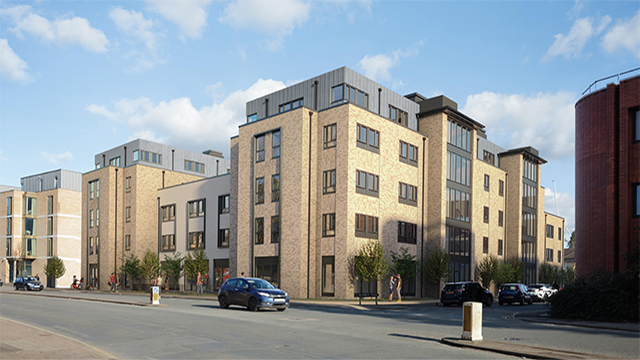Chris Stewart Group eyes UK expansion
Having laid the groundwork for major regeneration projects in Edinburgh and Glasgow, developer and investor Chris Stewart is looking to make his mark outside of Scotland for the first time.
Stewart’s eponymous property group is mulling redevelopment opportunities in Manchester, Dublin and London, which he says are “natural cities” for the group to expand to.
“We’re keen to grow,” he tells EG as he lays on an exclusive tour of mixed-use development The Edinburgh Grand, ahead of its launch on 1 June.
Having laid the groundwork for major regeneration projects in Edinburgh and Glasgow, developer and investor Chris Stewart is looking to make his mark outside of Scotland for the first time.
Stewart’s eponymous property group is mulling redevelopment opportunities in Manchester, Dublin and London, which he says are “natural cities” for the group to expand to.
“We’re keen to grow,” he tells EG as he lays on an exclusive tour of mixed-use development The Edinburgh Grand, ahead of its launch on 1 June.
“We’re trying to find the right thing and looking for city square product that would fit, but we’re taking our time. We want to pick the right spots and grow in a fairly considered way.”
The Chris Stewart Group – which specialises in regeneration while focusing on complex, listed buildings – currently has a £300m investment programme that Stewart says could “easily double” in the next five to 10 years, depending on how the market moves.
In 2014, the group received backing from US investment fund Proprium Capital to invest capital and act as a funding partner.
“It is pretty powerful to be able to own a freehold, control the operating model and income streams,” Stewart says.
The developer, who has not appointed any advisers to identify sites, is also open to joint ventures.
If locations are successfully determined, these cities could well establish developments similar to The Edinburgh Grand and its adjacent property, the Mint Building, which combined form an £85m mixed-use, privately-developed site known as The Registers.
Gearing up to launch
The Edinburgh Grand, formerly the iconic Royal Bank of Scotland’s headquarters at 42 St Andrew Square, will provide 50 serviced apartments when it opens later this week; meanwhile, the Mint Building will offer more than 60,000 sq ft of grade-A office space when construction completes in spring 2019.
[caption id="attachment_926492" align="aligncenter" width="847"] Family apartment at the Edinburgh Grand[/caption]
Stewart says The Edinburgh Grand should feel like a “combination of a high-end apartment with hotel services”, with access to a “buzzing late-night venue” as well as a gym.
Tenants at The Registers so far are two new entrants to Scotland: steakhouse restaurant Hawksmoor, which will take on a 3,000 sq ft space in July, and Manchester-based restaurant Tattu, which has signed for a 4,680 sq ft unit to launch in spring 2019.
The group is also finalising arrangements to install a basement gym at The Edinburgh Grand, and will operate a cocktail lounge.
However, occupiers will not necessarily be limited to the leisure sector. “It’s about what it can add to the development, not just letting the space.
“We have a list of people that will just pay rent but we want the offering to be commensurate with the investment that has been made,” says Stewart.
“It’s a long-term project for us so we won’t just short-term let them out – [we want] an offer in there for the next 15-20 years.”
A different offer
The Edinburgh Grand will provide around 100 beds across its nine floors, including a penthouse.
Among its selling points is its positioning as luxury hotel accommodation aimed at corporate longer-stay guests and leisure travellers, but it also offers “50% more space”, with similar price points as well as a 24-hour concierge service, in-house kitchen and catering capabilities.
[caption id="attachment_926493" align="aligncenter" width="847"] The apartments have locally sourced furniture and fabrics[/caption]
Although elements of the property have been kept intact to retain what Stewart calls its “old-school glamour”, such as doors and ironmongery dating back to the period between 1936 and 1942, its fabrics, flooring and furniture are bespoke designs that are mostly sourced locally.
Notably, local photographer Kevin McCollum and painter David Martin have populated the building with abstract artwork based on various stages of construction.
“All these little details keep it relevant. The design and operational side are as important as the real estate piece. It is all about delivering the product by taking our product knowledge in-house, rather than outsourcing everything,” says Stewart.
“It’s also more cost effective, doing it [this] way – it’s a leaner model, because you don’t have to go backwards and forwards.”
Regenerating Scotland
While Stewart has his eye on expanding further afield with sites such as The Registers, he is also keeping his attention firmly on Scotland.
He continues to work with the Department for International Trade on promoting investment into Scotland, and co-chairs the Scottish Real Estate Forum with Keith Brown, the cabinet secretary for the economy.
“We are constantly working with the government and its agents to help explain the market and how it works, [for] investors coming in,” Stewart says.
“All these little details keep it relevant. The design and operational side are as important as the real estate piece. It is all about delivering the product by taking our product knowledge in-house, rather than outsourcing everything,”
“We are trying to get the industry to communicate more effectively with stakeholders and the government, both local and national. Part of the problem in the past was [that] they didn’t talk to each other. It is not just about highlighting positive and negative issues but about coming up with ideas to help us solve them.”
For Stewart, the main roadblock to regeneration in Scotland is the lack of depth in terms of experience.
He explains: “[Looking at] complex regeneration, I think in Scotland there is not a huge depth of experience in terms of types of business and market knowledge is pretty key, so I’d like to see more sites happening and faster. There are sites that are sitting, bogged down, and need to move forward.
“It’s not just planning. Local authorities are trying their best – they just don’t have enough people. Demand for output for that is definitely there, but [it is about] solving the problems by [putting in place] processes to allow them to go through as efficiently as possible.
“But the market will stay difficult in development for some time; regionally it will [remain] a difficult business, so we have to try and get through it as efficiently as we can.”
The Chris Stewart Group – what you need to know
■ Founded by: Chris Stewart in 1996
■ Key projects: The Registers (mixed-use development, Edinburgh); George Street Complex (mixed-use development, Glasgow)
■ Completed developments include: Courtyard by Marriott (hotel, Edinburgh); Castle Street (residential, Edinburgh); The Devil’s Advocate (bar and restaurant, Edinburgh)
■ Funding partner: Secured backing from US investment advisory firm Proprium Capital in 2014
■ Potential future mixed-use project locations: Manchester, Dublin, London
To send feedback, e-mail pui-guan.man@egi.co.uk or tweet @PuiGuanM or @estatesgazette











